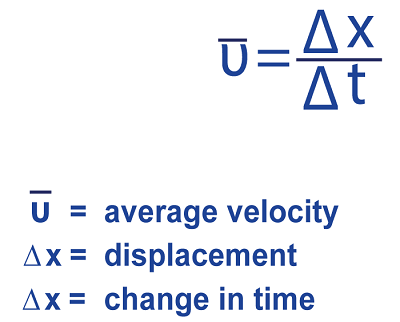Average Velocity DefinitionAverage velocity is a topic in physics (a branch of science) that describes the displacement covered by an object over a certain interval of time. This calculation is often used in scientific and engineering applications to calculate speed and distance. It plays a crucial role in understanding the movement of objects in space and time. Let us discuss average velocity in detail in this article. Velocity is the rate at which an object changes its relative position in a given period. It is calculated as the distance an object travels divided by the time taken to travel that distance. The term "average" in average velocity refers to the total displacement of an object over a period divided by the time taken. 
For example, if a car travels 120 miles in three hours, the average velocity of the car can be calculated as 120 miles / 3 hours = 40 miles per hour. This means the car travelled an average of 40 miles per hour over the three hours. Although this is not exact, and we cannot say that car is continuously travelling with this constant average velocity of 40 miles per hour, we get a rough idea of the car's velocity. We can use this data to solve further complex problems. Velocity and speed are both different terms. Please make sure to distinguish them. Velocity is often confused with speed, but they are not the same. While velocity (vector quantity) considers both the direction and magnitude of an object's displacement, speed (a scalar quantity) only considers the magnitude of the displacement. Speed has nothing to do with the direction of the object. This means that two objects with the same speed but different directions will have different velocities. Velocity can be defined as the rate at which a body alters its position in a particular direction. On the other hand, speed is defined as the rate at which a body travels or covers a unit distance (changes in the direction do not matter in this case). Being a vector quantity, velocity has both a magnitude and a direction. It can be estimated by figuring out an object's displacement over a brief time frame, like a tiny fraction of a second. This measurement is crucial for thoroughly examining how objects move, particularly when the object's velocity changes quickly. On the other hand, speed is a scalar quantity, meaning it has only magnitude and no direction. It is computed by dividing an object's total distance travelled by its transit duration. Regardless of any variations in velocity that may have occurred during that time, an object's average velocity considers its total displacement and the amount of time required. One significant difference between velocity and speed is that velocity considers the direction of motion and can be positive, zero, and even negative. In contrast, speed only considers the magnitude of the object's velocity and cannot be negative. For example, an object moving back and forth between two points at the same speed will have zero velocity. Still, its speed will be non-zero since it has covered a distance over time. SI unit of both velocity and speed is the same, that is, m/s. Average velocity has a lot of uses in the field of motion analysis, particularly in calculating an object's acceleration. The rate at which an object's velocity alters over time is called its acceleration. It is computed by dividing the velocity change by the time it took for that change to occur. Applications of Average VelocityNumerous other professions use average velocity, including physics, engineering, and sports. Its significance in the scientific and technical sectors, from sports and GPS technologies to motion analysis, cannot be emphasized. It has contributed to a better knowledge of the world in which we live. The following are some real-world uses for average velocity:
For instance, if a car accelerates from a velocity of 40 miles per hour to 60 miles per hour over 10 seconds, the acceleration of the car can be calculated as (60 miles per hour - 40 miles per hour) / 10 seconds = 2 miles per hour per second. This means the car's velocity increases by 2 miles per hour every second. Average velocity is mathematically expressed as the ratio of displacement to time, considering the direction of motion. It is an essential concept in physics and engineering, and its formula can be used to calculate the average velocity of an object in motion. Average velocity = Displacement / Time Where:
The displacement and time can be measured in any unit of length and time, respectively, as long as they are consistent. For example, if the displacement is measured in meters and the time in seconds, the average velocity will be expressed in meters per second (m/s). It is important to note that average velocity considers the direction of motion so that it can be positive or negative depending on the direction of the displacement. If the displacement is in the positive direction, the average velocity will be positive, and if it is in the negative direction, the average velocity will be negative. The formula for average velocity can also be expressed in terms of the initial and final velocities of an object: Average velocity = (Initial velocity + Final velocity) / 2 This formula assumes that the object's acceleration is constant, and it is used when the initial and final velocities of the object are known. However, the formula can only be used if the acceleration is constant. The average velocity has to be calculated using the displacement and time shown in the first formula. Some Solved Examples Based on Average VelocityExample 1: A train travels a distance of 200 km in 4 hours at a speed of 50 km/h. What is the average velocity of the train? Solution: We can use the formula, Average velocity = Displacement / Time. Displacement = 200 km Time = 4 hours Average velocity = 200 km / 4 hours = 50 km/h Therefore, the average velocity of the train is 50 km/h. 
Example 2: A car travels a distance of 120 km in 2 hours. What is the average velocity of the car? Solution: Using the formula, Average velocity = Displacement / Time Displacement = 120 km Time = 2 hours Average velocity = 120 km / 2 hours = 60 km/h Therefore, the average velocity of the car is 60 km/h. Example 3: A cyclist starts from point A and travels to point B at a speed of 20 km/h, then returns from point B to point A at 10 km/h. If the distance between point A and point B is 60 km, what is the average velocity of the cyclist for the entire journey? Solution: To calculate the average velocity of the cyclist, we first need to calculate the total displacement and time taken for the journey. Displacement = 0 km (since the cyclist ends up at the same point where he started) Time taken to reach point B = 60 km / 20 km/h = 3 hours Time taken to return from point B to point A = 60 km / 10 km/h = 6 hours Total time taken = 3 hours + 6 hours = 9 hours Using the formula, Average velocity = Displacement / Time Displacement = 0 km Time = 9 hours Average velocity = 0 km / 9 hours = 0 km/h Therefore, the average velocity of the cyclist for the entire journey is 0 km/h since the cyclist ends up at the same point where he started. Example 4: A truck travels 120 miles from city A to city B at 60 mph. On the return journey, the truck travels the same distance at 40 mph. What is the average velocity of the truck for the entire journey? Solution: To calculate the average velocity of the truck for the entire journey, we first need to calculate the total displacement and the total time taken. Displacement = 0 miles (since the truck ends up at the same point where it started) Time taken to travel from city A to city B = 120 miles / 60 mph = 2 hours Time taken to travel from city B to city A = 120 miles / 40 mph = 3 hours Total time taken = 2 hours + 3 hours = 5 hours Using the formula, Average velocity = Displacement / Time Displacement = 0 miles Time = 5 hours Average velocity = 0 miles / 5 hours = 0 mph Therefore, the average velocity of the truck for the entire journey is 0 mph since the truck ends up at the same point where it started. Example 5: A sprinter runs 400 meters in 45 seconds. What is the average velocity of the sprinter? Solution: Using the formula, Average velocity = Displacement / Time Displacement = 400 meters Time = 45 seconds Average velocity = 400 meters / 45 seconds = 8.89 m/s Therefore, the average velocity of the sprinter is 8.89 m/s. Example 6: A cyclist travels 10 miles at a speed of 15 mph and then continues to travel 20 miles at 10 mph. What is the average velocity of the cyclist for the entire journey? Solution: To calculate the average velocity of the cyclist for the entire journey, we first need to calculate the total displacement and time taken. Displacement = 10 miles + 20 miles = 30 miles Time taken to travel 10 miles = 10 miles / 15 mph = 0.67 hours Time taken to travel 20 miles = 20 miles / 10 mph = 2 hours Total time taken = 0.67 hours + 2 hours = 2.67 hours Using the formula, Average velocity = Displacement / Time Displacement = 30 miles Time = 2.67 hours Average velocity = 30 miles / 2.67 hours = 11.21 mph Therefore, the average velocity of the cyclist for the entire journey is 11.21 mph. ConclusionAverage velocity is a fundamental concept in physics that helps to determine the rate at which an object changes its position over time. It is essential in understanding the motion of objects, and it plays a critical role in various scientific and engineering applications. While it may seem simple, it has significant implications for understanding the world.
Next TopicBattery Definition
|
 For Videos Join Our Youtube Channel: Join Now
For Videos Join Our Youtube Channel: Join Now
Feedback
- Send your Feedback to [email protected]
Help Others, Please Share










